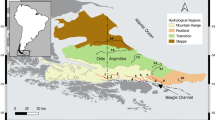Abstract
Since the late 20th century, the biomass of Pacific salmon Oncorhynchus spp. has increased. Hokkaido, northern Japan, is one of the main areas of chum salmon O. keta production in the North Pacific and intensive hatchery programs support the recent high abundance. However, proper management of naturally spawning populations is necessary to conserve healthy stocks of this species. In 2008, we started a program to assess the naturally spawning chum salmon populations in Hokkaido. Of the total of approximately 1,500 rivers in Hokkaido, 238 rivers with lengths of longer than 8 km (excluding those rivers used for hatchery broodstock collection) were surveyed in 2008 and 2009. The number of non-enhanced rivers found to contain naturally reproducing chum salmon was 59 (31.4% of surveyed rivers) and 50 (37.6% of surveyed rivers) rivers in 2008 and 2009, respectively. Including the rivers where hatchery broodstock were collected and rivers shorter than 8 km that contain naturally spawning chum salmon, chum salmon ascended at least 191 and 175 rivers in Hokkaido in 2008 and 2009, respectively. Repeated foot surveys indicated that the run timings of naturally spawning chum salmon may be affected by coastal commercial fisheries. This study showed that naturally spawning chum salmon remain in many rivers in Hokkaido where hatchery programs have been intensively conducted.






Similar content being viewed by others
References
Fukushima M (2005) The dam-related decline of freshwater fish diversity – analyses of the data collected from Hokkaido during the last half century. Jpn J Ecol 55:349–357
Kaeriyama M (1999) Hatchery programmes and stock management of salmonid populations in Japan. In: Howell BR, Moksness E, Svåsand T (eds) Stock enhancement and sea ranching. Blackwell Science, Oxford, pp 153–167
Kaeriyama M, Edpalina RR (2004) Evaluation of the biological interaction between wild and hatchery population for sustainable fisheries management of Pacific salmon. In: Leber KM, Kitada S, Blankenship HL, Svåsand T (eds) Stock enhancement and sea ranching, developments, pitfalls and opportunities, 2nd edn. Blackwell Science, Oxford, pp 247–259
Kobayashi T (1980) Salmon ranching in Japan. In: Thorpe JE (ed) Salmon ranching. Academic, London, pp 91–107
Mobrand L, Barr J, Blankenship HL, Campton DE, Evelyn TTP, Flagg TA, Mahnken CVW, Seeb LW, Seidel PR, Smoker WW (2005) Hatchery reform in Washington State: principles and emerging issues. Fisheries 30(6):11–23
Morita K, Saito T, Miyakoshi Y, Fukuwaka M, Nagasawa T, Kaeriyama M (2006) A review of Pacific salmon hatchery programmes on Hokkaido Island, Japan. ICES J Mar Sci 63:1353–1363
Nagata M (2002) Restoration of spawning and rearing habitats for masu salmon, Oncorhynchus masou in a channelized stream. Fish Sci 68(suppl II):1707–1710
Nagata M, Kaeriyama M (2004) Salmonid status and conservation in Japan. In: Gallaugher P, Wood L (eds) Proceedings from the World Summit on Salmon. Simon Fraser University, pp 89–97.
Nakamura F, Komiyama E (2010) A challenge to dam improvement for the protection of both salmon and human livelihood in Shiretoko, Japan’s third Natural Heritage Site. Landsc Ecol Eng 6:143–152
Quinn TP (1993) A review of homing and straying of wild and hatchery-produced salmon. Fish Res 18:29–44
Quinn TP (2005) The behavior and ecology of Pacific salmon and trout. University of Washington Press, Seattle, p 379
Ruggerone GT, Peterman RM, Dorner B, Myers KW (2010) Magnitude and trends in abundance of hatchery and wild pink salmon, chum salmon, and sockeye salmon in the North Pacific Ocean. Mar Coast Fish: Dyn Manag Ecosyst Sci 2:306–328
Saito T (2000) Natural reproduction of chum salmon in the Horonai Stream: spatial segregation of redd formation between chum salmon and other salmonids. Bull Natl Salmon Resour Cent 3:15–24
Suzuki T, Okamoto M, Aruga N (2005) Natural spawning of chum salmon in the Toyohira River, Hokkaido. NPAFC (North Pacific Anadromous Fish Commission) Tech Rep 6: 121
Acknowledgments
We acknowledge Makoto Fujiwara, Hirofumi Hayano, Hajime Omori, Yoshihito Shinriki, Kei-ichi Sugiwaka, Katsumi Takeuchi and researchers of the Hokkaido Fish Hatchery, Katsuya Nakao, Sachiyo Iimura, Houji Okada and staff of Hokkaido Aquaculture Promotion Corporation for their cooperation in the field survey. Comments from Peter Rand and anonymous reviewers are acknowledged. Masaya Takahashi kindly provided information on otolith marking of chum salmon. This study was funded by the Department of Fisheries and Forestry, Hokkaido Prefectural Government and Hokkaido Federation of Fisheries Cooperative Association.
Author information
Authors and Affiliations
Corresponding author
Rights and permissions
About this article
Cite this article
Miyakoshi, Y., Urabe, H., Saneyoshi, H. et al. The occurrence and run timing of naturally spawning chum salmon in northern Japan. Environ Biol Fish 94, 197–206 (2012). https://doi.org/10.1007/s10641-011-9872-5
Received:
Accepted:
Published:
Issue Date:
DOI: https://doi.org/10.1007/s10641-011-9872-5




